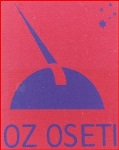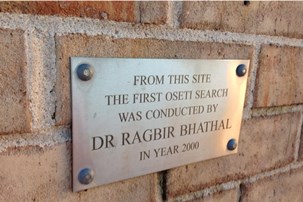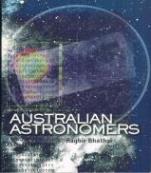Areas of Research and Teaching
- The OZ OSETI Project
- National Project on Significant Australian Astronomers and Physicists
- National Project on Aboriginal Astronomy
- Astronomy of the first people of Australia
- Optical Communications
- Engineering Physics
- Earth, Life and Space
The OZ OSETI PROJECT
This is a long term search for SETI in the optical spectrum. It is searching for nanosecond (extremely short) laser pulses from ETI. The system uses the coincidence technique to eliminate "false signals" which can be caused by cosmic rays and ion feedback. These "false signals" can occur if a single PMT is used. They rarely occur when two PMTs are used in coincidence mode as is the case for the OZ OSETI Project. It is the longest dedicated optical search for ETI in the Southern Hemisphere. It began in 1998 on an off-campus telescope at Mount Stromlo and in 2000 the first search was carried out at the Campbelltown Rotary Observatory. It uses both on campus and off-campus telescopes.

A laser look alike ETI signal from 47 Tucanae or NGC 104 was observed in December 2008 at the Observatory. A six month search for the signal to repeat itself was not observed again. It probably was a spurious signal, perhaps from cosmic rays.
For more information, please see:
- The case for Optical SETI (opens in a new window)
- Aliens With Lasers: SETI Bets On Nano-second Flashes From E.T. (opens in a new window)
(Forbes, 18 July 2012) - Flash in the pan may be messages from outer space (opens in a new window)
(The Sydney Morning Herald, 7 March 2001)
National Project on Significant Australian Astronomers and Physicists
Conversations conducted by Dr Ragbir Bhathal with significant Australian astrophysicists and physicists are held in the archives of the National Library of Australia. Please note there are conditions for use of these records. The highlights of significant discoveries made by some of the astrophysicists can be found in the book Australian Astronomers published by the National Library of Australia as a project of national significance and those of physicists in past issues of Australian Physics. Work on significant engineers is in progress.
| Astronomers and Astrophysicists | ||
|---|---|---|
| Bailes, Matthew | Couch, Warrick | Mills, Bernie |
| Bessell, Michael | Dopita, Michale | Minnett, Harry |
| Bland-Hawthorn, Joss | Ekers, Ron | Mould, Jeremy |
| Boyle, Brian | Frater, Bob | Petersen, Bruce |
| Bracewell, Ronald | Freeman, Ken | Sackett, Penny |
| Brown Hanbury | Gaensler, Bryan | Schmidt, Brian |
| Brown, Ronald Drayton | Gascoigne, S. C. B. | Staveley-Smith, Lister |
| Butcher, Harvey | Hunstead, Richard | Storey, John |
| Cannon, Russell | Manchester, Richard | Webster, Rachel |
| Christiansen, W. N. | Mathewson, Donald | Wild, Paul |
| Colless, Matthew | Melrose, Donald | |
| Physicists | ||
|---|---|---|
| Carver, John | Hurst, Charles | Pegg, David |
| Cole, Keith | Klein, Anthony | Stacey, Frank |
| Delbourgo, Robert | Makinson, Kathleen | Stalker, Raymond |
| Dracoulis, George | McKeller, Bruce | Williams, James |
| Garnett, Helen | Milburn, Gerard | |
| Hannaford, Peter | Opat, Geoffrey | |
National Project on Aboriginal Astronomy

This is an ongoing national project which is investigating 40,000 years of Aboriginal astronomy. It is examining archival records, stone arrangements, landscapes, rock engravings, oral memories, rock art and paintings which depict astronomical themes. It also holds discussions with Aboriginal people to obtain their perspective on the Aboriginal night sky.
Students who wish to do postgraduate studies in Aboriginal Astronomy and/or Aboriginal Education should contact Dr Ragbir Bhathal (r.bhathal@uws.edu.au). Their application will be discussed by Dr Ragbir Bhathal, Dr Les Vozzo and Terry Mason.
Astronomy of the first people of Australia
Like the other ancient peoples of the world the Aboriginal and Toress Strait Islander people have constructed oral narratives of the celestial bodies in the Australian night sky. Aboriginal astronomy is social-cultural astronomy and unlike modern astronomy it is not appropriate for it to be tested by the same methods of modern science or to infer scientific interpretations from the narratives. It is a belief system and it is classified under other knowledge traditions. To read more please download 'Astronomy of the first people of Australia'. (PDF, 593.53 KB) (opens in a new window)
Optical Communications
Engineering students undertaking communication units use the observatory for their projects and undergraduate studies. Engineering students also use the observatory for their engineering thesis and other engineering projects.
Engineering Physics
Students are exposed to optical principles and applications for their optical and light pollution studies. A blended learning project using specialised software to teach engineering physics to over 450 engineering students is under investigation.
Earth, Life and Space
This is an inquiry based science/engineering education project to motivate students to study science and engineering and to explore the natural world. The project is developing learning materials with hands-on experiments for the students to carry out.
Dr Ragbir Bhathal, Dr Les Vozzo and Terry Mason
Mobile options:

